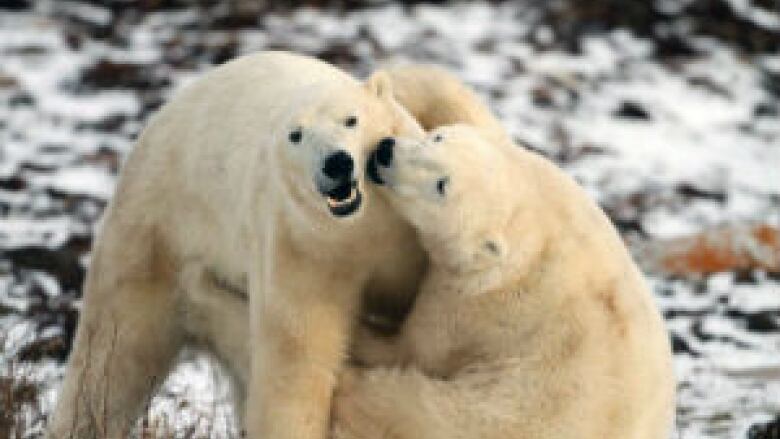Polar bear tranquillizers, collars do no lasting harm: study
James Eetoolook of Nunavut Tunngavik finds the conclusion 'hard to believe'

A newly published study says shooting polar bears withtranquillizer darts, handling them and leaving them with radio
collars doesn't do any lasting harm even if a bear is captured asmany as 10 times.
Despite long-standing concerns from many Inuit and somescientists about the effect on the bears, the U.S. Geological Surveystudy concludes the animals are moving normally within five daysafter being picked up.
"These shorter-term, post-capture effects do not appear to havetranslated into any long-term effects on body condition,
reproduction or cub survival," the study concludes. "Additionally,collaring had no effect on polar bear recovery rates, bodycondition, reproduction or cub survival."
Capture studies have long been controversial in the North.
Some earlier research has suggested using such techniques tostudy the bears harms them. Inuit hunters say the approach injuresthe bears, leaves them with chemical residues and shows disrespectto a culturally important animal.
"This intrusive method is not acceptable to the Inuit," saidJames Eetoolook of Nunavut Tunngavik Inc., which monitors theNunavut land claim.
The question has grown in urgency as climate change increasespressure to understand what's happening to bear populations.
The new study uses data collected from the South Beaufort Seapopulation, which Canada shares with the United States. It drew itsconclusions from the results of 3,800 captures between 1970 and2013.
"We had a great opportunity to look at the long term to see ifany animals are being negatively affected, and we are very pleasedto report we couldn't find any evidence like that," said SteveAmstrup, the study's lead author.
Researchers found 90 per cent of the bears reached their previouslevel of movement and activity within five days of being captured.
Body mass didn't seem to be different between bears that had beencaptured before and those that were being tranquillized for thefirst time. That held for bears that had been darted and studiedrepeatedly, up to 10 times.
Litter size didn't seem to be affected if the mother had beenpreviously captured. Cubs born to previously captured sows were thesame size as those born to non-captured moms. Nor was the mamabear's ability to look after her young affected by wearing a radiocollar.
As well, attaching radio collars didn't seem to have anydifferent impact than ear tags or glue-on transmitters.
Nunavut Tunngavik skeptical
Eetoolook finds the conclusions "hard to believe."
Collars, he said, inhibit the bears' movement and make it harderfor them to hunt seals through the ice or in open water. Huntershave found dead bears wearing collars, he said.
Scientists should find a more modern way to study the animals andlean more about Inuit traditional knowledge, Eetoolook suggested.
"The Inuit respect wildlife, so therefore they don't handle wildanimals. We're not going to agree to anything that affects the livesof polar bears."
Steve Pinksen of Nunavut's Environment Department said theterritory has been moving toward less handling of bears during itsresearch.
Amstrup said aerial surveys only provide a snapshot of bearnumbers and don't give any information on the condition of theanimals. Genetic analysis of hair samples can yield valuable data as long as the samples are uncontaminated, from single individualsand collected over a long enough period.
"By capturing animals, over time, you get an opportunity tolearn the details of the sex and age composition, the health of theanimals, the changes in the animal's growth over time, whether ornot they reproduce and how many times," Amstrup said. "All thosethings you simply can't get by any other method."












_(720p).jpg)


 OFFICIAL HD MUSIC VIDEO.jpg)
.jpg)



























































































